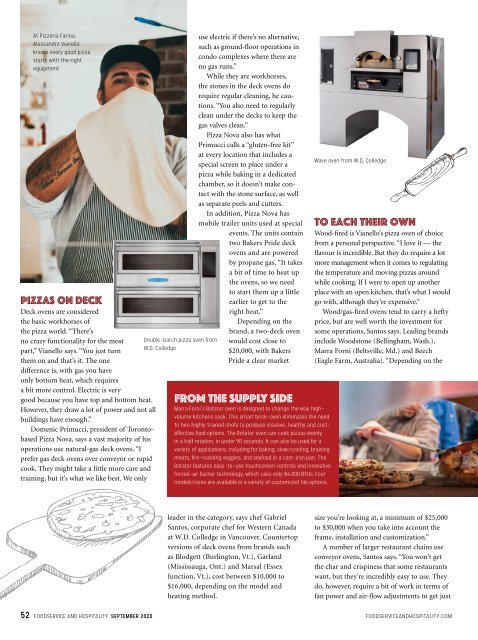September 2020
September 2020 issue of Foodservice and Hospitality magazine.
September 2020 issue of Foodservice and Hospitality magazine.
You also want an ePaper? Increase the reach of your titles
YUMPU automatically turns print PDFs into web optimized ePapers that Google loves.
At Pizzeria Farina,<br />
Alessandro Vianello<br />
knows every good pizza<br />
starts with the right<br />
equipment<br />
Pizzas on deck<br />
Deck ovens are considered<br />
the basic workhorses of<br />
the pizza world. “There’s<br />
no crazy functionality for the most<br />
part,” Vianello says. “You just turn<br />
them on and that’s it. The one<br />
difference is, with gas you have<br />
only bottom heat, which requires<br />
a bit more control. Electric is very<br />
good because you have top and bottom heat.<br />
However, they draw a lot of power and not all<br />
buildings have enough.”<br />
Domenic Primucci, president of Torontobased<br />
Pizza Nova, says a vast majority of his<br />
operations use natural-gas deck ovens. “I<br />
prefer gas deck ovens over conveyor or rapid<br />
cook. They might take a little more care and<br />
training, but it’s what we like best. We only<br />
Double-batch pizza oven from<br />
W.D. Colledge<br />
use electric if there’s no alternative,<br />
such as ground-floor operations in<br />
condo complexes where there are<br />
no gas runs.”<br />
While they are workhorses,<br />
the stones in the deck ovens do<br />
require regular cleaning, he cautions.<br />
“You also need to regularly<br />
clean under the decks to keep the<br />
gas valves clean.”<br />
Pizza Nova also has what<br />
Primucci calls a “gluten-free kit”<br />
at every location that includes a<br />
special screen to place under a<br />
pizza while baking in a dedicated<br />
chamber, so it doesn’t make contact<br />
with the stone surface, as well<br />
as separate peels and cutters.<br />
In addition, Pizza Nova has<br />
mobile trailer units used at special<br />
events. The units contain<br />
two Bakers Pride deck<br />
ovens and are powered<br />
by propane gas. “It takes<br />
a bit of time to heat up<br />
the ovens, so we need<br />
to start them up a little<br />
earlier to get to the<br />
right heat.”<br />
Depending on the<br />
brand, a two-deck oven<br />
would cost close to<br />
$20,000, with Bakers<br />
Pride a clear market<br />
From the Supply Side<br />
Marra Forni’s Rotator oven is designed to change the way highvolume<br />
kitchens cook. This smart brick-oven eliminates the need<br />
to hire highly trained chefs to produce creative, healthy and costeffective<br />
food options. The Rotator oven can cook pizzas evenly<br />
in a half rotation, in under 90 seconds. It can also be used for a<br />
variety of applications, including for baking, slow roasting, braising<br />
meats, fire-roasting veggies, and seafood in a cast-iron pan. The<br />
Rotator features easy-to-use touchscreen controls and innovative<br />
forced-air burner technology, which uses only 84,000 BTUs. Four<br />
models/sizes are available in a variety of customized tile options.<br />
Wave oven from W.D. Colledge<br />
To each their own<br />
Wood-fired is Vianello’s pizza oven of choice<br />
from a personal perspective. “I love it — the<br />
flavour is incredible. But they do require a lot<br />
more management when it comes to regulating<br />
the temperature and moving pizzas around<br />
while cooking. If I were to open up another<br />
place with an open kitchen, that’s what I would<br />
go with, although they’re expensive.”<br />
Wood/gas-fired ovens tend to carry a hefty<br />
price, but are well worth the investment for<br />
some operations, Santos says. Leading brands<br />
include Woodstone (Bellingham, Wash.),<br />
Marra Forni (Beltsville, Md.) and Beech<br />
(Eagle Farm, Australia). “Depending on the<br />
leader in the category, says chef Gabriel<br />
Santos, corporate chef for Western Canada<br />
at W.D. Colledge in Vancouver. Countertop<br />
versions of deck ovens from brands such<br />
as Blodgett (Burlington, Vt.), Garland<br />
(Mississauga, Ont.) and Marsal (Essex<br />
Junction, Vt.), cost between $10,000 to<br />
$16,000, depending on the model and<br />
heating method.<br />
size you’re looking at, a minimum of $25,000<br />
to $30,000 when you take into account the<br />
frame, installation and customization.”<br />
A number of larger restaurant chains use<br />
conveyor ovens, Santos says. “You won’t get<br />
the char and crispiness that some restaurants<br />
want, but they’re incredibly easy to use. They<br />
do, however, require a bit of work in terms of<br />
fan power and air-flow adjustments to get just<br />
52 FOODSERVICE AND HOSPITALITY SEPTEMBER <strong>2020</strong> FOODSERVICEANDHOSPITALITY.COM


















